| Views of the Moon |
|---|
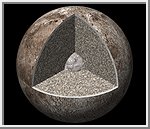 The Lunar Interior
The Lunar Interior
This picture shows the 3 major divisions of the Lunar interior, the crust, mantle, and core. The lunar crust thickness varies from tens of kilometers in depth (under mare basins) to more than 100 kilometers in some highland regions, with an average thickness of about 70 kilometers. The core radius is between 300 and 425 kilometers.
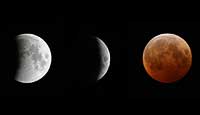 2004 Lunar Eclipse
2004 Lunar EclipseOn Wednesday October 27, 2004 the moon passed into Earth's shadow for more than three hours. It began at 9:14 p.m EST with totality beginning at 10:23 p.m. and ending at 11:45 p.m. The eclipse passed out of Earth shadow at 00:54 a.m (Oct. 28).
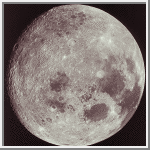 Apollo 17 - Whole Moon View
Apollo 17 - Whole Moon ViewThis full disc of the Moon was photographed by the Apollo 17 crew during their trans-Earth coast homeward following a successful lunar landing mission in December 1972. Mare seen on this photo include Serentatis, Tranquillitatis, Nectaris, Foecunditatis and Crisium.
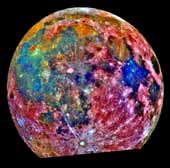 Moon - False Color Mosaic
Moon - False Color Mosaic
This false-color photograph of the Moon was taken by the Galileo spacecraft on December 8, 1992. The false-color processing used to create this lunar image is helpful for interpreting the surface soil composition. Areas appearing red generally correspond to the lunar highlands, while blue to orange shades indicate the ancient volcanic lava flow of a mare, or lunar sea. Bluer mare areas contain more titanium than do the orange regions. Mare Tranquillitatis, seen as a deep blue patch on the right, is richer in titanium than Mare Serenitatis, a slightly smaller circular area immediately adjacent to the upper left of Mare Tranquillitatis. Blue and orange areas covering much of the left side of the Moon in this view represent many separate lava flows in Oceanus Procellarum. The small purple areas found near the center are pyroclastic deposits formed by explosive volcanic eruptions. The fresh crater Tycho, with a diameter of 85 kilometers (53 miles), is prominent at the bottom of the photograph.
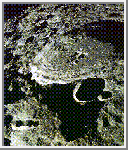 Far Side of the Moon
Far Side of the Moon
This image was taken by Apollo 11 astronauts in 1969. It shows a portion of the Moon's heavily cratered far side. The large crater is approximately 80 km ( 50 miles ) in diameter. The rugged terrain seen here is typical of the farside of the Moon.
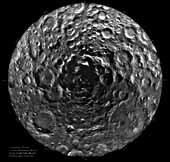 Lunar South Pole
Lunar South PoleThis mosaic is composed of 1,500 Clementine images of the south polar region of the Moon. The top half of the mosaic faces Earth. Clementine has revealed what appears to be a major depression near the lunar south pole (center), evident from the presence of extensive shadows around the pole. This depression probably is an ancient basin formed by the impact of an asteroid or comet. A significant portion of the dark area near the pole may be in permanent shadow, and sufficiently cold to trap water of cometary origin in the form of ice. The impact basin Schrodinger (near the 4 o'clock position) is a two-ring basin, about 320 kilometers (200 miles) in diameter which is recognized to be the second youngest impact basin on the Moon. The center of Schrodinger is flooded by lavas. A volcanic vent seen in the floor of Schrodinger is one of the largest single explosive volcanoes on the Moon
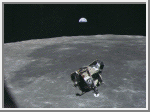 Apollo 11
Apollo 11
The Apollo 11 Lunar Module (LM) ascent stage, with Astronauts Neil A. Armstrong and Edwin E. Aldrin Jr. aboard, is photographed from the Command and Service Module (CSM) during rendezvous in lunar orbit. The LM was making its docking approach to the CSM. Astronaut Michael Collins remained with the CSM in lunar orbit while the other two crewmen explored the lunar surface. The large, dark-colored area in the background is Smyth's Sea, centered at 85 degrees east longitude and 2 degrees south latitude on the lunar surface (nearside). This view looks west. The Earth rises above the lunar horizon
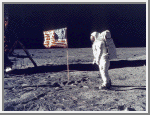 Apollo 11 - Flag
Apollo 11 - FlagAstronaut Edwin E. Aldrin Jr., lunar module pilot, poses for a photograph beside the deployed United States flag during Apollo 11 extravehicular activity on the lunar surface. The Lunar Module Eagle is on the left. The footprints of the astronauts are clearly visible in the soil of the Moon. This picture was taken by Astronaut Neil A. Armstrong, commander, with a 70mm lunar surface camera.
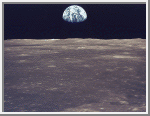 Apollo 11 - Earth from the Moon
Apollo 11 - Earth from the MoonThis view of the Earth rising over the Moon's horizon was taken from the Apollo 11 spacecraft. The lunar terrain pictured is in the area of Smyth's Sea on the nearside.
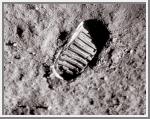 Apollo 11 - Footprint on the Moon
Apollo 11 - Footprint on the MoonA close-up view of an astronaut's footprint in the lunar soil, photographed with a 70mm lunar surface camera during the Apollo 11 extravehicular activity (EVA) on the Moon.
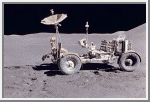 Apollo 15 - Lunar Roving Vehicle
Apollo 15 - Lunar Roving VehicleThis is a view of the Lunar Roving Vehicle photographed alone against the desolate lunar background during an Apollo 15 lunar surface extravehicular activity (EVA) at the Hadley-Apennine landing site. This view is looking north. The west edge of Mount Hadley is at the upper right edge of the picture. Mount Hadley rises approximately 4,500 meters (14,800 feet) above the plain. The most distant lunar feature visible is approximately 25 kilometers (16 miles) away.
 Apollo 17 - Taurus-Littrow Landing Site
Apollo 17 - Taurus-Littrow Landing SiteThis is the landing site of the last Apollo mission (Apollo 17). It was in the valley among the Taurus-Littrow hills on the southeastern rim of Mare Serenitatis. Astronauts Eugene Cernan and Harrison H. Schmitt explored the valley with the aid of an electrically powered car. This image shows Schmitt inspecting a huge boulder that has rolled down the side of an adjacent hill.
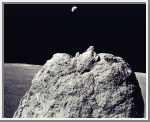 Apollo 17 - Large Lunar Boulder
Apollo 17 - Large Lunar BoulderEarth in the far distant background is seen above a large lunar boulder on the Moon. This photo was taken with a handheld Hasselblad camera by the last two Moon walkers in the Apollo Program.
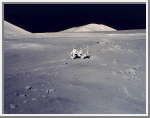 Apollo 17 - Lunar Scape
Apollo 17 - Lunar ScapeThis image is an excellent view of the desolate lunar space at Station 4 showing scientist-astronaut Harrison H. Schmitt, lunar module pilot, working at the Lunar Roving Vehicle during the second Apollo 17 extravehicular activity at the Taurus-Littrow landing site. This is the area where Schmitt first spotted the orange soil which is visible on either side of the Lunar Roving Vehicle in this picture. Shorty Crater is to the right, and the peak in the center background is Family Mountain. A portion of South Massif is on the horizon at the left edge.
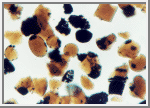 Apollo 17 - Orange Soil
Apollo 17 - Orange SoilThese orange glass spheres and fragments are the finest particles ever brought back from the Moon. The particles range in size from 20 to 45 microns. The orange soil was brought back from the Taurus-Littrow landing site by the apollo 17 crewmen. Scientist-Astronaut Harrison J. Schmitt discovered the orange soil at Shorty Crater. The orange particles, which are intermixed with black and black-speckled grains, are about the same size as the particles that compose silt on Earth. Chemical analysis of the orange soil material has show the sample to be similar to some of the samples brought back from the Apollo 11 (Sea of Tranquility) site several hundred miles to the southwest. Like those samples, it is rich in titanium (8%) and iron oxide (22%). But unlike the Apollo 11 samples, the orange soil is unexplainably rich in zinc. The orange soil is probably of volcanic origin and not the product of meteorite impact.
 Limb of Copernicus Impact Crater
Limb of Copernicus Impact CraterThis image of Copernicus was acquired on the Lunar Orbiter 5 Mission. Copernicus is 93 kilometers wide and is located within the Mare Imbrium Basin, northern nearside of the Moon (10° N, 20° degrees W.). Image shows crater floor, floor mounds, rim, and rayed ejecta. Rays from the ejecta are superposed on all other surrounding terrains which places the crater in its namesake age group: the Copernican system, established as the youngest assemblage of rocks on the Moon (Shoemaker and Hackman, 1962, The Moon: London, Academic Press, p.289-300).
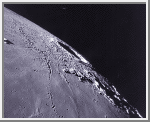 Apollo 17 - Oblique view of Copernicus
Apollo 17 - Oblique view of CopernicusThis is an oblique view of the large crater Copernicus on the lunar nearside, as phtographed from the Apollo 17 spacecraft in lunar orbit.
No comments:
Post a Comment